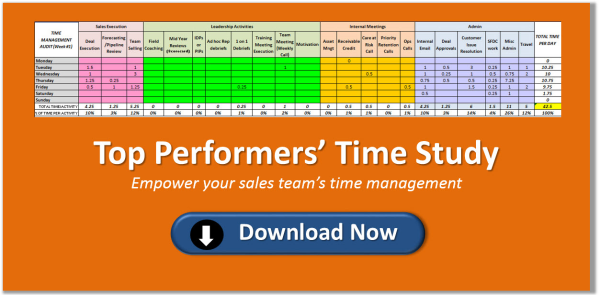Top sales performers share a common trait – relentless time management. This is the story of my day last week with the #1 sales rep for a B2B technology firm. It started at 6:15 a.m. with an email from Jerry confirming our rendezvous at Starbucks. This post will reveal what makes Jerry successful. And what prevents him from even greater success.
This post will also help HR and Sales leaders answer a vexing question: “What do we need to do to retain and empower our top sales talent?” It also provides a free tool to diagnose your top performers’ challenges.
“The war for talent is over, and the talent won.”
This is a quote from Josh Bersin’s annual Ten Predictions for HR published last week. In this 2014 edition he predicts that “HR organizations will shift their focus from cost reduction to retention and engagement.” Bersin explains:
“This year the power will shift: high-performing employees will start to exert control. Top people with key skills will be in short supply. Thanks to the US healthcare laws, people will feel more free to change jobs.
More than 60% of organizations tell us one of their top priorities is dealing with “the overwhelmed employee.”
What does this mean for Jerry and the top performers in your organization?
Overwhelmed is the Enemy of Overachievement
Jerry’s day was extremely productive. Not a moment was wasted. His calendar was packed with customer interactions. Between sales calls, he ceaselessly worked his smartphone. Email and phone conversations filled the day. He set reminders to himself in his calendar for follow-up actions. Before the day started, he had stocked his calendar with tasks. Jerry wasn’t reacting to emails, he was executing on his priority list.
I asked Jerry to name the biggest challenge to his success. He said, “40% of my time is spent doing other peoples’ jobs.” By his own estimate, Jerry works 60-75 hours per week. Forty percent of his time equals 24 hours. That’s 3 days each week.
Imagine how productive Jerry could be if his time was dedicated to selling.
Whose Job Is It Anyway?
Jerry said, “Our company’s growing rapidly. We’ve added a lot of new support people to implement our solutions and care for our customers. But, in the short term, it’s killing me. The new hires don’t have the skills to the do the job yet. So, I have to constantly follow up. I’m project managing my project managers.”
Reporting is another time drain. Jerry leverages his CRM system to manage his opportunities. But the bi-weekly forecast is done on a spreadsheet. Instead of relying on the data in the system, Jerry wastes time updating the same information in Excel.
Pricing exceptions are another killer. Technology firms face intense price competition. Jerry’s finance organization has implemented an internal process to manage discounts. Although the process protects margins, it saps valuable selling time from his day. He estimates that 90 minutes a day are lost to paperwork and internal processes.
Where Does the Time Go?
Elite sales performers are excellent at time management. They are also overwhelmed. Failure to manage the demands on their time makes them a turnover risk.
Companies are also constantly squeezing costs. Administrative and support roles have no direct ROI, so they are easy targets for elimination. But the work still needs to be done. So, it often falls to Sales.
HR and Sales leaders need to understand how sales people spend their time. This knowledge allows leaders to attack the root causes of role corruption. Simply knowing that 40% of the day is non-selling isn’t enough. Figuring out how to win back that time is the key. A time study can pinpoint the activities that drain hours from sales efforts.
How Do Top Performers Spend Their Time?
There are many ways to determine where selling time goes. Direct observation, like my day with Jerry provides a comprehensive view. But a simple time study be just as effective. Here’s how:
- Download the free SBI Time Study Template
- Explain to the sales team that this will pinpoint areas to reduce time pressure on them
- Launch a 2-week time study
- Review the reports at the end of Week 1 to ensure there are no issues
- Close the study at the end of Week 2 and publish the results for the participants to see
- Launch initiatives to fix the most wasteful time drains
- Communicate the status of the initiatives to the sales force and celebrate success
Top sales reps want to maximize their time efficiency. They understand the value of every selling minute. Helping them be more effective improves retention. Make your Number in 2014 by protecting and expanding your top sales reps’ selling hours.




